Tile is a go-to choice for bathroom renovations because of its durability, water resistance, and endless design possibilities. Unlike wood or carpet, tile can handle constant moisture and splashes, making it ideal for wet areas.
Beyond practicality, tiles come in a range of materials that each offer a unique style — from budget-friendly basics to high-end luxury finishes. Whether you’re sprucing up a small powder room or designing a lavish master bath, choosing the right tile material can elevate the look and function of your space.
Below, we explore five types of tile that homeowners should consider for a bathroom remodel, highlighting what makes each material special, its pros and cons, and what you might expect to pay.
Remodeling your kitchen instead? Check out the 5 types of tile to consider for a kitchen renovation. If you need help from the tile experts, visit our Tile Services page to learn more about how we help.
Porcelain Tile
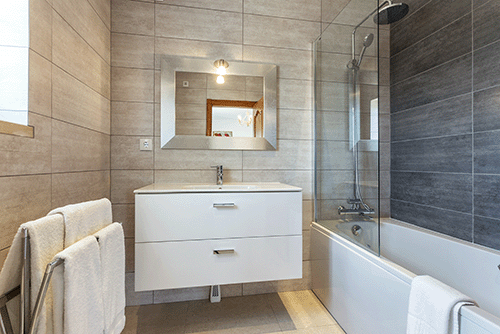
Key Features of Porcelain Tile
Porcelain tile is a type of ceramic tile made from highly refined clay fired at very high temperatures. This process creates an extremely hard, dense tile with very low water absorption (often less than 0.5%). Porcelain tiles come glazed or unglazed and can be made in a variety of shapes and sizes, from standard squares to large-format rectangles. They are known for their ability to convincingly mimic other materials — you can find porcelain tiles that look like marble, travertine, concrete, or even hardwood planks.
This makes porcelain a versatile option for achieving high-end looks with less maintenance. Key features of porcelain include its strength, resistance to moisture, and through-body color (meaning the tile’s color and pattern run through its thickness, which helps hide chips). It’s suitable for both bathroom floors and walls, and many porcelain tiles are rated for use in wet areas like showers.
Benefits
- Waterproof and Durable: Porcelain is one of the most water-resistant tile materials available. Its density and low porosity mean it won’t absorb water readily, making it highly resistant to mold and water damage. It also stands up well to heavy foot traffic and scratches, so it can last for decades without significant wear.
- Stain Resistant: Most porcelain tiles are glazed, giving them a non-porous surface that resists staining from soaps, dyes, or cosmetics. Even unglazed porcelain has a tight structure that makes it less prone to staining than softer tiles. Spills can be wiped up easily without leaving a trace.
- Mimics High-End Materials: Because of advanced printing and manufacturing techniques, porcelain can impersonate pricier materials (like marble or wood) almost indistinguishably. Homeowners can achieve a luxury look with porcelain tiles that are easier to maintain than the real thing.
- Good for Heated Floors: Porcelain’s density allows it to work well with radiant floor heating systems. It tolerates temperature changes without cracking and efficiently conducts heat.
- Low Maintenance: Day-to-day care is simple — regular mopping or wiping keeps porcelain clean. It doesn’t require sealing or special cleaners, and its hard surface resists scratches and wear.
Drawbacks
- Higher Cost than Basic Ceramic: Porcelain tends to be more expensive per square foot than standard ceramic tile due to its material quality and manufacturing process.
- Difficult Cutting and Installation: The density that makes porcelain durable also makes it challenging to cut. DIY installers often find that porcelain requires a wet saw with a diamond blade for clean cuts.
- Heavy Weight: Porcelain tiles are heavier than many other tiles. This is usually fine for floors, but for walls or shower ceilings, ensure your substrate can support the weight.
- Cold and Hard Underfoot: Like all ceramic-based tiles, porcelain has a hard, unforgiving feel. It can be chilly on bare feet (unless heated) and offers no cushioning if someone falls on it.
Cost Expectations
Porcelain tile generally ranges from approximately $3 to $10 per square foot for most styles. Designer porcelains, wood-look planks, or large-format slabs can cost more, with some premium options reaching $20–$30+ per sq. ft. This does not include installation labor. While porcelain is typically more than basic ceramic, many homeowners consider its extra durability and low upkeep worth the investment.
Ceramic Tile
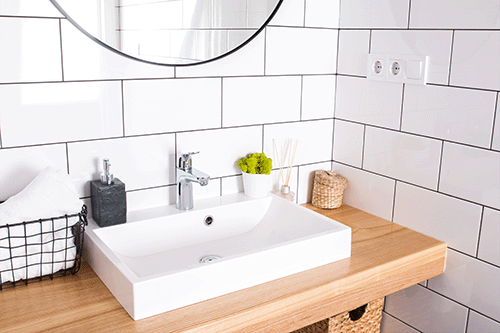
Key Features of Ceramic Tile
Ceramic tile is a classic choice for bathrooms and one of the most common tiling materials. Like porcelain, ceramic tiles are made from clay, but usually a less refined clay and fired at slightly lower temperatures. This makes ceramic a bit more porous and slightly softer than porcelain. Ceramic tiles often have a glazed surface finish that carries the tile’s color and pattern.
They come in a huge variety of shapes (squares, rectangles, hexagons, etc.), sizes, and colors – from plain white subway tiles to vividly patterned Spanish or Moroccan designs. Key features of ceramic tile include its ease of cutting/installation (compared to porcelain) and its budget-friendly cost for standard tiles. Ceramic is suitable for bathroom floors and walls, but you’ll want to choose a tile rated for floor use if installing on the ground.
Benefits
- Affordable and Accessible: Ceramic tile is known for its wallet-friendly price point, making it attractive for budget-conscious renovations. Basic ceramic tiles can cost well under $1 per square foot.
- Wide Variety of Designs: You can find ceramic tiles in almost any color, pattern, or texture, from glossy glazed ceramics to handmade artisanal tiles.
- Easy to Work With: Ceramic is generally easier to cut and drill than porcelain because it’s a bit softer. It’s often lighter in weight too, reducing labor time and costs.
- Durable for Everyday Use: Ceramic tile can handle daily foot traffic, resists scratches, and, when glazed, won’t easily absorb stains or odors.
- Low Maintenance Finish: Most ceramic tiles have a protective glaze that makes cleaning simple. Routine cleaning with mild soap and water keeps ceramic tile looking new.
Drawbacks
- Higher Water Absorption (if Unglazed): Standard ceramic is more porous than porcelain. Unglazed ceramic tile must be sealed to improve water resistance.
- Less Strength and Durability: Ceramic is not as dense as porcelain, so it’s more prone to chipping or cracking under heavy impact.
- Cold and Hard Surface: Like porcelain, ceramic tile can be cold underfoot without radiant heating. It’s also hard with no cushioning.
- Maintenance of Grout Lines: Ceramic tile installations will have grout lines that require periodic sealing and cleaning to prevent staining or mildew.
- Limited Slip Resistance: Many ceramic tiles have a glossy finish that can be slippery when wet. Opt for matte or textured finishes for floors.
Cost Expectations
Ceramic tile is one of the most cost-effective materials for bathrooms. Basic ceramic tiles can start at around $0.50–$2 per square foot, while mid-range options might be $3–$5 per sq. ft. High-end or specialty ceramics can go up to $10–$15+ per sq. ft. Even at the higher end, ceramic is generally cheaper than porcelain or natural stone, making it a go-to choice for larger surfaces or tighter budgets.
Marble Tile
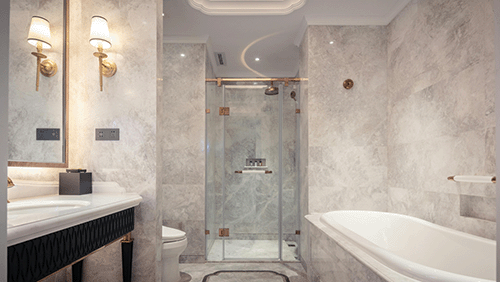
Key Features of Marble Tile
Marble is a natural stone prized for its beauty and luxury appeal. Each marble tile is quarried from real stone, typically with dramatic veining and rich depth of color. Common marbles for bathrooms include Carrara, Calacatta, Crema Marfil, and Black Marquina, among others. Marble tiles come in various sizes and finishes. A polished finish is glossy and reflective, while a honed finish is matte and provides better slip-resistance.
Marble conveys a timeless, high-end look and is often used on floors, walls, and shower surrounds in premium remodels. Because it’s a form of limestone that has metamorphosed, marble is somewhat softer than granite but still considered durable for residential bathrooms. Its ability to elevate a bathroom’s design and potential for boosting resale appeal make it a popular choice for luxury spaces.
Benefits
- Elegant, Timeless Aesthetic: Marble’s distinctive veining creates a one-of-a-kind design. It’s been used in grand homes for centuries and instantly elevates décor.
- Unique Natural Patterns: No two marble tiles are identical, giving your bathroom a distinctive, natural beauty.
- Adds Real Estate Value: Marble is often seen as a premium feature that can enhance a home’s value.
- Durability (with Care): With proper sealing and maintenance, marble can last a lifetime. It’s heat-resistant and won’t easily crack under normal bathroom use.
- Cool and Comfortable in Warm Climates: Marble stays naturally cool, which can be refreshing in hot or humid conditions.
Drawbacks
- High Cost: Marble is among the most expensive tile options, with some premium varieties reaching $20–$50+ per sq. ft.
- Porous and Stain-Prone: Marble needs regular sealing to protect against liquids. Acidic substances (e.g., vinegar) can etch the surface.
- Scratch and Etch Sensitivity: Marble is softer than granite and can scratch or dull if not properly maintained.
- Slippery When Wet: Polished marble can be quite slick; a honed finish or smaller tiles can help improve traction.
- Requires Professional Installation: Marble is tricky to install correctly and typically needs experienced professionals.
Cost Expectations
Marble tile sits at the high end of the price spectrum, starting around $8–$15 per square foot for standard Carrara-type marble, with premium or exotic varieties running $20–$50+ per sq. ft. Professional installation will add significantly to the total cost. If you want marble’s luxurious look at a lower cost, consider using it selectively as an accent rather than throughout the entire bathroom.
Travertine Tile
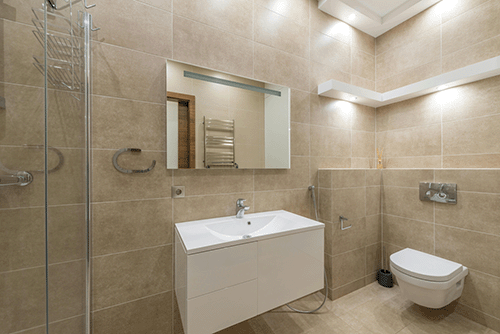
Key Features of Travertine Tile
Travertine is another popular natural stone used in bathrooms, noted for its warm, earthy appearance. It’s a form of limestone deposited by mineral springs, often showing fibrous patterns and small pits or holes in its surface. Common shades include beige, ivory, tan, and walnut, though silver-gray and gold varieties exist. Travertine is most often used with a honed or tumbled finish for a matte, non-slip surface that suits floors and showers. It evokes a classic, Old-World style reminiscent of Mediterranean and Roman baths.
Travertine tiles are frequently “filled” (the natural holes are filled with resin or cement), then honed to create a flatter surface. Like marble, travertine requires sealing to protect against moisture and stains, but it offers a warm, timeless look for those seeking natural stone at a lower cost than marble.
Benefits
- Natural, Warm Aesthetic: Travertine brings an inviting, spa-like ambiance with its neutral tan and cream tones.
- Non-Slip Surface: The honed or tumbled finish provides decent traction in wet areas, making it popular for bathroom floors and showers.
- Cool and Comfortable: Like other stone, travertine remains cool to the touch in warm climates and can pair well with radiant heating.
- Hides Dirt and Wear: The mottled pattern and warm hues conceal minor dirt or water spots. It can develop a patina that some people love.
- Moderate Cost (Compared to Marble): Travertine is often more affordable than marble or granite, offering a natural stone option with mid-range pricing.
Drawbacks
- Porous and Needs Sealing: Travertine’s natural voids and holes make it susceptible to water and stains if not sealed.
- Erodes and Wears Over Time: It can wear down or dull more easily than harder stones, especially under harsh cleaners or heavy traffic.
- Sensitivity to Acids: Like marble, travertine can be etched by acidic substances and requires pH-neutral cleaners.
- Color Change and Patina: Travertine may darken in areas that remain wet if sealant wears thin, and it can develop a weathered look.
- Installation and Repair Considerations: Proper sorting, placement, and subfloor reinforcement are important. Matching replacements can be tricky if tiles crack.
Cost Expectations
Travertine tile typically ranges from around $3 to $15 per square foot. Lower-end products might be smaller tiles or more common colors with visible fills. Mid-range and high-end travertine can run $6–$15/sq. ft. or more, depending on the quality, finish, and tile size. It’s a good compromise between a truly budget-friendly ceramic and the high-end look of marble, but keep in mind the extra maintenance and sealing requirements.
Glass Tile

Key Features of Glass Tile
Glass tile is exactly what it sounds like — tile made from glass, often in mosaic form (e.g., 1×1 or 1×2 inch pieces on mesh sheets). It comes in a vast array of colors, finishes (glossy, frosted, iridescent), and textures. Glass tiles can be clear, solid-colored, or even printed with patterns. They are completely non-porous, so they’re impervious to water, making them ideal for shower walls, backsplashes, and decorative borders.
Glass tiles reflect light, brightening the space and adding visual interest. Because of their higher cost and potential slipperiness, they’re typically used as accents rather than primary bathroom flooring, though small mosaic glass tiles can be used on shower floors where grout lines add traction. If you want a splash of color or a unique focal point, glass tile is a fantastic option.
Benefits
- Waterproof and Non-Porous: Glass does not absorb moisture at all, making it mold- and mildew-resistant.
- Easy to Clean: A simple wipe or glass cleaner removes spots and soap residue. No sealing is required.
- Aesthetic Impact: Glass reflects light, adding brightness and often a shimmer or metallic look. It can make small bathrooms feel larger and more open.
- Versatility in Design: Glass mosaics come in endless patterns, colors, and mixes (glass can be combined with stone or metal too).
- Resists Mold and Mildew: Since it’s non-porous and typically installed with impermeable grout, it doesn’t harbor growth.
Drawbacks
- Expensive Material: Many glass mosaics cost $10–$30 per sq. ft. or more, plus higher installation costs.
- Prone to Scratches: Glass can scratch more easily than porcelain or ceramic, so abrasive cleaners and floor use can be an issue.
- Slippery (Not Floor-Friendly): Smooth glass tiles can be dangerously slick when wet. If used on floors, choose a small mosaic or a slip-resistant texture.
- Potential for Chipping or Cracking: Glass can chip at edges if hit hard. Repairs may be noticeable if tile color or style is discontinued.
- Installation Challenges: The transparency requires careful adhesive application to avoid show-through, and cutting glass needs specialized tools.
Cost Expectations
Glass tile generally falls on the higher end of the spectrum for bathroom materials. Simple glass mosaics might start around $5 per sq. ft., but more typical quality or decorative designs range from $10–$20 or more. Premium or designer glass tiles can easily exceed $25 per sq. ft. Because most homeowners use glass as an accent (e.g., a backsplash or shower niche), you often don’t need a large amount, which helps manage costs. Labor costs may be higher due to the precision required, but the overall expense can remain moderate if used judiciously.
So – What Should You Choose?
When deciding, consider the needs of your household: for a family bathroom with heavy use, porcelain or slip-resistant ceramic may be ideal. For a showpiece master bath, marble or travertine can create a spa-like atmosphere if you’re willing to maintain it. Budget-conscious renovators can mix and match materials to achieve a high-end look without overspending — for instance, using ceramic on large surfaces and adding glass or marble accents for visual interest.
Always think about maintenance and how much effort you’re willing to invest in upkeep. And remember, a good installation is crucial for long-term durability, so it often pays to hire an experienced installer.

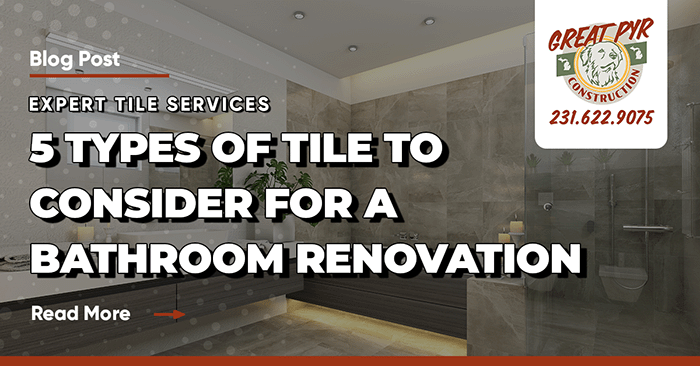
Comments (1)
dxbijm